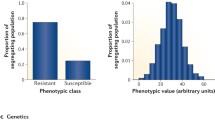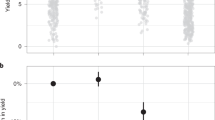Abstract
Durable disease resistance and sustainable agriculture are two important concepts that have not been defined well enough for many people to determine with certainty whether a particular entity fits into either category. While there is not agreement on either definition, there is little disagreement that each concept is a desirable objective. Ironically, both concepts can be reduced to `over a long period of time'. While most people would not argue with the indefinite characterization of either concept, disagreement quickly arises when consideration begins of how to achieve either. Most disease resistance that is rendered ineffective is race specific. The pathogen population is shifted genetically to defeat the resistance gene. When resistance is only partial, the population shifts are less likely to occur. Equally so, the more complex the genetics of the resistance, the more difficult it is for the pathogen to evolve to a form that can overcome the resistance. Throughout history, there are countless examples of major losses of crops when previous effective resistance has been rendered ineffective, causing severe hardship and even devastating famines, e.g., Irish potato famine. Fortunately, there are also examples of resistance that has given protection over an extended time, one is rust in maize. Ultimately, adding genetic complexity to many host plant resistances is likely to extend their effectiveness (greater durability). Similarly, adding biodiversity to the landscape for both plants and animals is likely to increase the resiliency of the ecosystem involved. In both cases, the derived food system will be more secure.
Similar content being viewed by others
References
Aspelin, A.L. & A.H. Gruber, 1997. http: //www.epa.gov/oppbead1/pestsales/97pestsales/table2.htm.
Aykroyd, W.R., 1974. The Conquest of Famine, London: Chatto and Windus.
Bourke, A. 1993. 'The Visitation of God?': The Potato and the Great Irish Famine. Jacqueline Hill & Cormac Ó. Gráda (Eds.), Dublin.
Flavin, C., 2001. Rich planet, poor planet. In: L.R. Brown et al. (Eds.), State of the World, 2001, pp. 3-20. A Worldwatch Institute Report on Progress Toward a Sustainable Society, W.W. Norton & Company, New York.
Hooker, A.L., 1972. Southern leaf blight of corn - Present status and future prospects. J Environ Quality 1: 244–249.
Jacobs, Th. & J.D. Parlevliet, 1993. Durability of Disease Resistance. Kluwer Academic Publishers, Agricultural University, Wageningen, The Netherlands.
Johnson, R., 1993. Durability of disease resistance in crops: some closing remarks about the topic and the symposium. In: Th. Jacobs & J.E. Parlevliet (Eds.), Durability of Disease Resistance, pp. 283–300. Kluwer Academic Publishers, The Netherlands.
Large, E.C., 1940. The Advance of the Fungi. Henry Holt & Company, New York.
Mattoon, A., 2001. Deciphering amphibian declines. In: L.R. Brown et al. (Eds.), State of the World, 2001, pp. 63-82. A Worldwatch Institute Report on Progress Toward a Sustainable Society, W.W. Norton & Company, New York.
McMullen, M., R. Jones & D. Gallenberg, 1997. Scab of wheat and barley: A re-emerging disease of devastating impact. Plant Disease 81: 1340–1347.
Padmanabhan, S.Y., 1973. The great Bengal famine. In: K.F. Baker, G.A. Zentmyer & E.B. Cowling (Eds.), Annual Review of Phytopathology, vol. 11, pp. 11–26. Annual Reviews Inc., Palo Alto, CA.
Peters, S.J., K.P. Lehman, J. Ristau, O. Ukaga & D. Wyse, 2000. The promise and challenges of the regional agricultural and natural resources sustainable development partnerships. In: Just in time Research: Resilient Communities, Hubert H. Humphrey Institute of Public Affairs, University of Minnesota Extension Service.
Schumann, G.L., 1991. Plant Diseases: Their Biology and Social Impact. APS Press, The American Phytopathological Society, St. Paul, MN.
Sen, A., 1990. Public Action to Remedy Hunger (The Hunger Project). The Fourth Annual Arturo Tanco Memorial Lecture, London.
Stuthman, D.D., L.C. Federizzi & D. Wyse, 1999. Breeding for sustainable agriculture. In: A. Borem, M.P. Giddice & N.S. Sakiyama (Eds.), Plant Breeding in the Turn of the Millennium, Biowork II Workshop, Federal University of Vicosa, Brazil.
Sustainable America: A New Consensus for Prosperity, Opportunity, and a Healthy Environment for the Future, 1996. In: The President's Council on Sustainable Development, Washington, DC.
Weatherford, J., 1988. Indian Givers: How the Indians of the Americas Transformed the World. Fawcett Columbine, New York.
Wolfe, M.S., 2000. Crop strength through diversity. Nature 406: 681–682.
Zhu, Y., H. Chen, J. Fan, Y. Wang, Y. Li, J. Chen, J. Fan, S. Yang, L. Hu, H. Leung, T.W. Mew, P.S. Teng, Z. Wang & C.C. Mundt, 2000. Genetic diversity and disease control in rice. Nature 406: 718–722.
Author information
Authors and Affiliations
Rights and permissions
About this article
Cite this article
Stuthman, D.D. Contribution of durable disease resistance to sustainable agriculture. Euphytica 124, 253–258 (2002). https://doi.org/10.1023/A:1015694803221
Issue Date:
DOI: https://doi.org/10.1023/A:1015694803221




